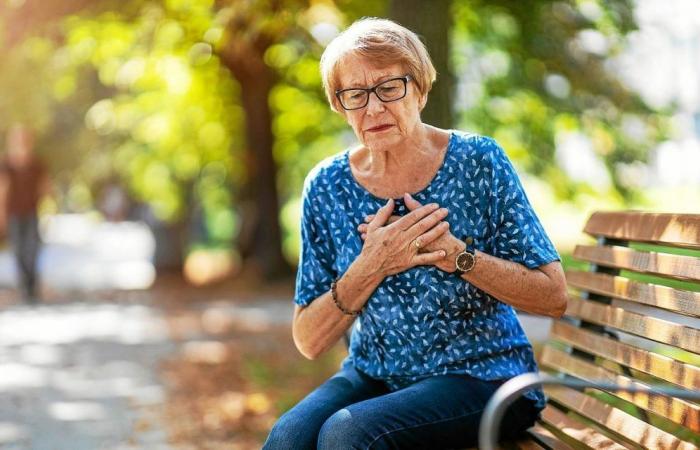
1. Smoking : it is particularly toxic for female arteries. Three to four cigarettes per day triple the cardiovascular risk in women (5).
2. Diabetes: Cardiovascular mortality is higher in diabetic women than in diabetic men, with a significantly higher relative risk of fatal coronary heart disease.
3. Cholesterol: When “bad cholesterol” is high, it accumulates on the artery walls in the form of fatty deposits. Over time, these deposits can slow down and even block blood circulation: this is atherosclerosis.
4. Sedentary lifestyle : half an hour of walking a day can be enough to reduce cardiovascular risk. By being active, you limit your weight gain, you reduce the risk of diabetes and high blood pressure, you limit the level of fats in the blood.
5. High blood pressure: we speak of high blood pressure when, on several occasions, the systolic pressure is greater than 140 mmHg (14 cmHg) and/or the diastolic pressure is greater than 90 mmHg (9 cmHg).
6. Alcohol consumption: maximum two glasses/day and not every day (6).
7. Overweight and obesity: we speak of overweight if the body mass index (BMI) is greater than 25, and of obesity if it is greater than 30.
Note that “if several of these factors coexist, the risks of contracting cardiovascular disease are higher” (7).
140,000 dead
Cardiovascular diseases remain the cause of around 140,000 deaths per year in France (8).
Risk factors specific to women
– The age of the first period (less than 11 years or more than 15 years);
– polycystic ovary syndrome;
– endometriosis;
– la contraception oestro-progestative ;
– hypertension of pregnancy;
– premature ovarian failure (below 40 years);
– the number of pregnancies (three and more);
– gestational diabetes;
– early menopause (under 45 years of age);
– menopausal flushing (more than six per day);
– breast cancer with chemotherapy radiotherapy;
– breast calcifications.
According to Claire Mounier-Véhier, cardiologist at Lille University Hospital, psycho-social stress as well as violence against women “also play a significant role. » “Women must listen to themselves and no longer hesitate to get tested. Family history, and particularly that of the parents, are key indicators: if they have had coronary problems, they must inform the doctor and carry out a cardiovascular assessment,” indicates the Fondation Agir pour le Cœur des Femmes.
Cardiovascular diseases kill eight times more than breast cancer.
Why is the risk of dying from cardiac arrest twice as high in women?
When cardiac arrest occurs outside of the hospital, women have twice the risk of death compared to men (9).
– The first barrier is the lack of recognition of cardiac arrest itself, considered as a male event: which causes a delay in the treatment of victims. “When a woman collapses in the street, we first think that it is vagal discomfort, not a heart problem. This can waste precious minutes! », notes Dr Mounier-Véhier.
– The second barrier is the fear of massaging a woman’s chest: some passers-by are embarrassed to touch a woman’s chest, others wrongly think that breasts hinder effective cardiac massage.
The obstacle course for women facing cardiac arrest does not end there:
– their hormonal situation may expose them more to heart attack;
– with a higher life expectancy than men, women therefore find themselves more alone at home as they age. However, when cardiac arrest occurs at home, without witnesses, the chances of survival decrease drastically… Every second counts in the face of an ACR.
– Finally, last explanation: women pay less attention to their own health (and their symptoms!) than to that of their loved ones…
Recognize the characteristic signs of a heart attack in women
Beyond the classic symptoms in both men and women (sudden, intense, vice-like pain in the chest radiating into the left arm – or both arms – and the jaw; which can be accompanied by paleness, discomfort, sweating, shortness of breath, nausea, belching (burping), anxiety), infarction in women can manifest itself through other more atypical symptoms:
– shortness of breath;
– palpitations ;
– digestive symptoms (nausea, discomfort or gastric burning);
– exhaustion or severe fatigue;
– feeling of anxiety and imminent danger;
– sharp pain in the upper back, between the shoulder blades or in the neck;
– cold sweats.
If in doubt, call emergency services (15, 112 or 18).
Note that these symptoms may have started to appear in the days preceding a heart attack. It is therefore important to know your risk factors and pay attention to what is out of the ordinary: shortness of breath during exercise, greater fatigue, small tightness or points in the chest that come and go, discomfort in the arm at the effort, burning that goes up into the throat…
How to react to an RTA?
We must act very quickly. Every second counts. The more time passes without doing anything, the more irreversible the damage will be. “1 minute saved means 10% more chance of survival! » (10).
To increase the victim’s chances:
1. Recognize cardiac arrest: the victim has lost consciousness, he does not react when spoken to or stimulated, he is no longer breathing (his chest does not rise).
2. Alert emergency services: 15 (Samu), 18 (firefighters) or 112.
3. Dare to massage and effectively: by positioning yourself above the victim, placed on a hard surface. The arms should always be straight. Place the palms of your hands on top of each other, in the middle of the chest and exert pressure on the rib cage, then release. “Massaging a beating heart has no consequences. Daring to massage can really make the difference between life and death” (11).
4. Use the external defibrillator without fear: if there is one nearby, it will be brought by another witness, while waiting for help to arrive. All you have to do is follow the instructions transmitted orally by the device.
5. Pass the baton to the rescue teams.
Sources
(1) Agir pour le Coeur des Femmes Foundation.
(2), (6) Public Health France.
(3) Act for the Hearts of Women.
(4), (10) Act for the Hearts of Women.
(5) Act for the Hearts of Women.
(7) Ameli.fr.
(8) Ministry of Health.
(9) European Heart Journal 2019.
(10) French Cardiology Federation





